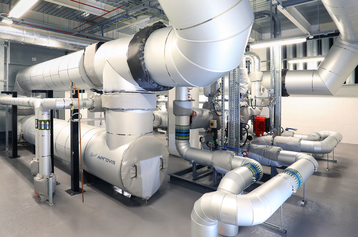Environmental and regulatory issues are starting to have an impact on data center operators’ back-up power. And more regulation, particularly in the EU, is expected to arrive very soon. Hence, data center operators need to start examining their back-up power installations now in order to be prepared.
But few data centers, however hard operators try to create a uniform fleet, are the same. Furthermore, different data centers in different parts of the world have different challenges to overcome, not just in terms of water, power and so on, but also differing customer demands – and, increasingly, the environmental demands from customers.
And that’s before new environmental regulations are introduced, which in addition to imposing new obligations in terms of efficiency, energy use and heat re-use, could further restrict noise and the length of time that diesel backup generators are allowed to run.
Indeed, probably top of the environmental hit list at the moment is diesel.
Backup engines fueled by diesel account for around 80 percent of the data center market today, and for a number of good reasons: it’s tried and trusted technology with a good depth of industry knowledge for maintenance; the footprint of diesel engines is advantageous compared to alternative technologies; and, they’re cheap to buy and run compared to the alternatives,” says Peter Herzner, Senior Sales Manager – OEM, at Aprovis.
He continues: “But the shortcomings of diesel engines for backup power generation are also many and the challenges to the technology are growing: diesel engine emissions are replete with particulates, which filters can reduce, but not completely eliminate; while emitting less CO2 than many fossil fuels, its carbon emissions remain significant; and, diesel engines are relatively noisy and certainly don’t make good neighbors in and around residential areas.”
Furthermore, with the sale of diesel vehicles plunging, it’s only a matter of time before diesel backup gets the same treatment.
Diesel decisions
Unfortunately, there are no perfect, ready-made replacements for diesel, as yet.
Battery technology is a long way from being able to run a data center for long enough to cover potential downtime, and hydrogen is not even a contender at the moment. In any case, with current production technologies, hydrogen largely only shifts CO2 production from combustion to the manufacturing stage, as it requires more-or-less as much energy to produce it as it provides.
Nuclear-powered data centers are even further off, and probably wouldn’t go down well with many people in many parts of the world.
That leaves natural gas, which already accounts for around a 20 percent share of the backup market, a share that is growing every year.
While, of course, still a fossil fuel, it nevertheless offers significantly lower CO2 and other emissions. “Gas is quieter than diesel and doesn’t require large-scale storage because gas backup engines can be plumbed into the national gas grids already built-out in markets across the world,” says Tim Mahnke, Project Manager, Benelux, for Aprovis.
That also means that extended downtime won’t require data center staff to desperately scuttle to and from the local service station for more diesel (if it’s available).
Furthermore, gas backup engines can potentially be monetized to provide grid balancing services to national power grids, helping to support highly variable renewable power technologies, while earning the data center a modest income on its ‘insurance policy’ against downtime. They can also be utilized should, say, wind turbines stop moving due to a lull in the weather, taking pressure off the grid.
In other words, gas may not be the perfect answer, but for many data center operators it will be a big improvement on what they have at the moment, a positive contributor to their sustainability roadmaps, and will also be ready for the switch to ‘green hydrogen’ when green gases comes of age.
“Depending on the hours of operation, we calculate relative CO2 emission reductions of approximately 30 percent for gas compared to diesel,” says Nils Warburg, Chief Aprovis representative in Southeast Asia.
Moreover, adds Warburg, when used as a base-load energy supply combined with CCHP [Combined Cooling Heat and Power], where the gas engine is combined with a vapour absorption machine producing cooling power for the data center, it can save an additional 22-25 percent in carbon emissions.
Indeed, gas backup engines provide more options for data center operators looking for more flexibility in terms of their power options, and the excess heat provided by gas engines can also be re-used – for example, in district heating schemes – unlike with diesel.
Nevertheless, gas isn’t without its drawbacks, especially as there’s more to methane than pure CH4 [carbon and hydrogen], and at the kind of scale that a typical hyperscale data center might be using gas, it will also require some exhaust treatments – Aprovis’s specialisation.
In addition to carbon monoxide, natural gas also generates nitrogen oxides (NOx), carbon dioxide (CO2), nitrous oxide (N2O), formaldehyde (HCHO), volatile organic compounds (VOCs), trace amounts of sulfur dioxide (SO2), and some particulates (although not in anywhere near the same quantities as diesel) in its exhaust gas.
“Our equipment is used for emission reduction and noise attenuation. So our focus is on the complete exhaust gas system after the engine,” Manuel Scherb, Head of Team CSE at Aprovis, told DCD back in August.
While Aprovis provides the full range of silencers, catalytic converters, and other exhaust gas treatments for diesel, the company’s focus today is in natural gas. Aprovis provides integrated systems which work with big OEM backup engine suppliers such as Caterpillar, Innio and Cummins, says Scherb. “We deal with all the OEMs and make for them one system, but our focus is not the engine, but everything after the engine.”
As a result, data center operators can effectively have their gas (or diesel) backup engines, offering between 50KW and 10MW power output, tailor-made for them, reducing one of the many technical headaches involved in specifying backup systems.
“Project specific demands on emissions and heat recovery in combination with renewable energy induced grid volatility are, and will be, challenges for the future to guarantee the data center’s operational safety and cost effectiveness. APROVIS, as a turnkey exhaust-system supplier, is best prepared to face this challenge – we hyperscale tailor-made solutions,” says Mahnke.
More...
-

Sponsored Gas works: The journey to more sustainable data centers will mean a shift from diesel to natural gas for backup generation
Gas is quieter and cleaner than diesel, but gas backup generators can be made even quieter and cleaner with silencers, catalytic converters and other technology, says Aprovis´s Manuel Scherb
-

When natural gas beats the grid
We ask Equinix why it is using fuel cells as an alternative to the once-reliable US grid

